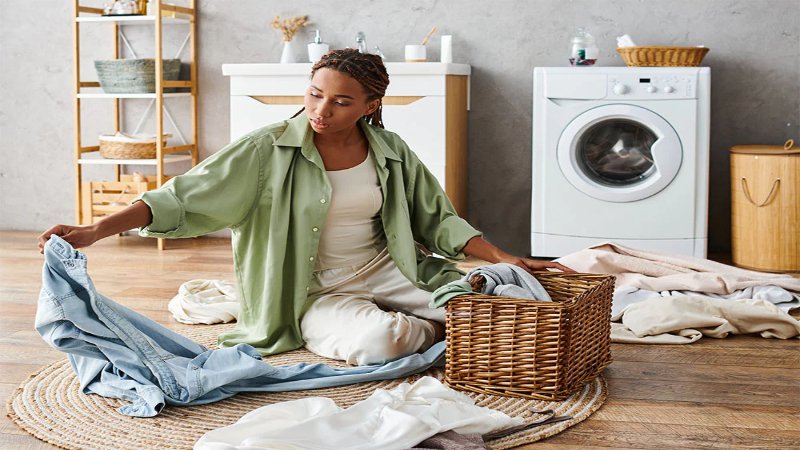Sort Laundry by Color: The Ultimate Guide to Prevent Bleeding
Color bleeding turning your whites pink, once-vibrant clothes fading into dullness, whites looking dingy no matter how many times you wash them? If you’re a beginner just starting to tackle laundry, or someone simply frustrated with these common problems, you’re not alone.
Sorting laundry by color can seem confusing and mistakes can lead to wasted time re-washing clothes and ruining your favorite items. But imagine laundry day becoming effortless, your clothes staying bright and new, and your whites truly sparkling. This guide is your solution. We’ll provide a clear, step-by-step approach to sorting laundry by color, arm you with expert tips to prevent common laundry mishaps. Let’s read!
1. Why Sorting Laundry by Color is Non-Negotiable (and How It Saves Your Wardrobe)
1.1 The Hidden Dangers of Mixed Loads: Color Bleeding and Fading
The consequences of tossing a mixed load of laundry together can be visually jarring and deeply frustrating. Imagine the disappointment of pulling out once-vibrant clothes now marred by unsightly streaks or unwanted tints. This is the reality of color bleeding, also known as dye transfer, where loose dyes from brightly colored items leach out during washing and indiscriminately stain lighter garments.
Beyond dramatic color changes, fading clothes are another insidious outcome of neglecting to sort. Washing darks with lights repeatedly can accelerate color loss, leaving your favorite pieces looking dull and washed-out far before their time. These laundry disasters are not just minor inconveniences; they represent damage to your clothing and a waste of your hard-earned money.

1.2 Beyond Aesthetics: Extending the Life of Your Clothes Through Smart Sorting
While preventing color mishaps is a primary benefit, the advantages of smart sorting extend far beyond mere aesthetics. Proper sorting is intrinsically linked to clothing lifespan and garment longevity. Different colors often require different washing temperatures and cycles.
Washing delicate fabrics with heavy-duty items, or subjecting vibrant colors to harsh detergents intended for whites, can lead to premature fabric wear and tear. This improper washing, over time, weakens fibers, causes pilling and diminishes the overall quality of your clothes.
Effective sorting is a cornerstone of fabric care, ensuring each garment is washed under conditions that are gentle yet effective, maximizing its usable life. Embracing sustainable laundry practices, which includes diligent sorting, is not just about preserving your wardrobe; it’s a responsible approach to clothes care tips that reduces textile waste and promotes a more mindful cycle of consumption.
2. Decoding the Color Code: Your Expert Guide to Laundry Sorting Categories
2.1 Whites: The Pursuit of Brightness (and Bleach – Use Wisely!)
The goal for whites laundry is simple: achieving and maintaining bright whites. This category is reserved for items that are unequivocally white, think white t-shirts, socks, underwear, bed linens and towels. The aim here is to prevent any hint of dinginess and keep them looking fresh and pristine. Chlorine bleach can be a powerful ally in the quest for bright whites, effectively removing stains and whitening fabrics.
However, use bleach for whites wisely and sparingly. Overuse of chlorine bleach can actually damage fabric fibers, leading to premature wear and even yellowing over time. For delicate whites, or if you prefer to avoid harsh chemicals, consider oxygen bleach as a gentler alternative. Oxygen bleach is still effective at brightening and stain removal but is less aggressive on fabrics and colors.
2.2 Lights: Pastels, Prints, and the Perils of Dye Run
Lights laundry is a broader category encompassing more than just white. This group includes pastel colors like light blues, yellows, pinks and lavender as well as light colored clothes such as creams, off-whites, and light greys.
Crucially, this category also includes printed items that have a white or light-colored background, even if they feature colored designs. The primary concern with lights is the potential for dye run. Even seemingly colorfast dyes in prints can sometimes bleed, especially in warmer water, leading to unwanted tints on the lighter base fabric.

2.3 Darks: Maintaining Richness and Avoiding Fading
Darks laundry is where you’ll place your dark colored clothes, think blacks, deep blues like navy blue, browns, greys and dark reds and greens. The main objective with darks is prevent fading and maintain the richness and depth of their colors. Dark dyes are more prone to fading with repeated washing, especially if not cared for properly.
2.4 Brights: Handle with Care! Preventing the Rainbow Run
Brights laundry is the category for your most vibrant and intensely colored garments. This includes red clothes, orange clothes, pink clothes, yellows, bright greens, and purples – essentially, any color that is strikingly vivid.
The risk of color bleeding brights is significantly heightened in this category. Bright dyes are often less stable and more likely to leach out, especially during the first few washes. Imagine a ” rainbow run” – a chaotic mix of dyes bleeding and transferring, turning your once-bright load into a muddy mess.
2.5 Patterned Items: Decoding the Dominant Hue
Sorting patterned clothes laundry such as striped clothes, plaid and floral prints, can sometimes feel a bit tricky. The key is to identify the dominant color in the pattern. Look at the overall impression of the garment. If a striped shirt has navy blue and white stripes, navy blue is the dominant color. For floral prints, consider the background color and the most prominent colors in the floral design.

3. Beyond Color: Fabric Type and Soil Level – Advanced Sorting Strategies
3.1 Heavy Duty vs. Delicate Duty: Matching Fabric to Wash Cycle
Different fabrics have vastly different needs when it comes to washing. Heavy fabrics, such as jeans laundry and towels laundry, are robust and can withstand more agitation and higher temperatures. Conversely, delicate fabrics laundry like silk laundry and lace laundry, are fragile and require gentle handling.
Mixing these vastly different fabric types in the same wash cycle is a recipe for disaster. Washing heavy fabrics laundry with delicate fabrics laundry can lead to damage. The rough action needed to clean heavy items can be too harsh for delicates, causing tearing, stretching or distortion.
3.2 The Grime Factor: Sorting by Soil Level for Optimal Cleanliness
The soil level laundry of your clothes is another crucial sorting factor often overlooked. Heavily soiled clothes such as work clothes covered in dirt or gym clothes saturated with sweat, require a more intensive wash to get truly clean.
Mixing these with lightly soiled clothes like items worn briefly or simply needing a refresh, is not only inefficient but can also be counterproductive. The dirt and grime from heavily soiled clothes can redeposit onto lightly soiled clothes during the wash cycle, leaving everything less clean than desired.
3.3 Special Fabric Considerations: Denim, Sheets, Towels, and Athletic Wear
Certain common fabric categories deserve special attention due to their unique characteristics and laundry needs.
- Denim Laundry: New denim laundry is notorious for dye bleeding. Always wash new denim items separately for the first few washes to prevent dye transfer to other clothes. Even for older denim, it’s best to wash laundry tips denim inside out and use cold water to minimize fading and preserve the color.
- Sheets and Bedding Laundry: Sheets and bedding laundry are in close contact with your skin and can harbor dust mites, body oils, and allergens. For hygiene reasons, it’s recommended to wash laundry tips sheets and bedding in hot water (if the fabric allows – always check care labels) to effectively kill germs and remove allergens. Wash your bedding at least once a week, or more frequently if needed.
- Towels Laundry: Towels laundry tend to produce a lot of lint and can also harbor bacteria and mildew, especially if left damp. Wash laundry tips towels in hot water for optimal hygiene. It’s also advisable to wash and dry towels laundry separately from clothing to prevent lint transfer and maintain towel fluffiness.
- Athletic Wear Laundry: Athletic wear laundry is designed to wick away sweat, but this also means it can trap odors and bacteria. Wash athletic wear laundry separately as soon as possible after workouts to prevent odors from setting in. Avoid using fabric softener on athletic wear, as it can coat the fibers and reduce their wicking ability, and may even trap odors.
4. Laundry Sorting Don’ts: Items That Always Deserve Solo Washes
4.1 The “No-Mix” List: Protecting Your Clothes and Washing Machine
There’s a clear rationale behind designating certain items for items to wash alone. It’s all about protect clothes from damage and protect washing machine from potential issues. Here’s a breakdown of items that should always be washed separately:
- Embellished Clothes (beads, sequins, etc.): Garments adorned with embellished clothes like beads, sequins, or delicate appliqués are beautiful but fragile. During the agitation of a wash cycle, these embellishments can easily detach. Loose beads and sequins can not only damage other garments in the load by snagging or scratching them, but they can also get lodged in your washing machine’s mechanism, potentially causing malfunctions.
- Velcro and Zippers: While seemingly innocuous, velcro laundry closures and exposed zippers laundry can be surprisingly destructive in a mixed wash. The hooks of Velcro can latch onto delicate fabrics, causing pulls and tears. Similarly, exposed zippers, especially metal ones, can snag and damage more delicate items. Furthermore, zippers can bang against the washing machine drum, potentially causing scratches or dents over time.
- Non-Colorfast Items: Non-colorfast items are the ultimate dye-bleeding culprits. Washing them with anything else is practically guaranteed to result in a laundry mistake to avoid – a color-run disaster. These items release excessive amounts of dye, which can stain everything else in the wash load, often irreversibly.
- New Clothes Laundry: Particularly new clothes laundry items that are brightly colored or deeply dyed (especially reds, blues, and blacks) are notorious for initial dye release. Even if they seem colorfast, it’s always prudent to wash new clothes laundry separately for their first wash or two. This precaution minimizes the risk of dye bleeding and protects the rest of your wardrobe from accidental staining.
By diligently adhering to this “no-mix” list and giving these specific items solo washes, you’ll significantly reduce the risk of laundry mishaps, keep your clothes in better condition, and even prolong the life of your washing machine.

5. Pro Laundry Sorting Hacks: Making Laundry Day Easier and More Efficient
5.1 The Inside-Out Advantage: Protecting Colors and Fibers
One of the simplest yet most effective laundry hack inside out is to turn clothes inside out before tossing them into the wash. This seemingly minor step offers a multitude of benefits. Firstly, it significantly helps to protect clothes color.
The outer, visible side of your garments is the most susceptible to fading from detergent and wash cycles. By turning clothes inside out, you shield the vibrant outer layers, preserving color richness for longer. Secondly, it aids in protect fabric fibers.
The agitation of washing can cause friction and wear, especially on delicate fabrics. Turning clothes inside out minimizes abrasion on the outer surface, reducing pilling and wear and tear. Finally, it actually facilitates better cleaning.
The inner side of your clothes is typically where most of the body soil, sweat, and odor reside. Turning garments inside out allows detergent to directly target these areas, resulting in a more thorough and effective clean where it’s needed most.
5.2 Pre-Treat Like a Pro: Stain Removal Before Sorting
Elevate your laundry routine by adopting the professional laundry tips of pre-treat stains. Addressing stains before you even begin stain removal laundry sorting is a game-changer. Why pre-treat before sorting? Because it prevents accidental stain transfer.
Imagine pre-treating a heavily stained item and then sorting it with other clothes – you avoid the risk of accidentally smearing or transferring that stain onto cleaner garments during the sorting process itself. Pre-treating also maximizes stain removal effectiveness. By tackling stains early, you give stain removers more time to work their magic, increasing the chances of complete stain removal during the wash cycle.
5.3 The Multi-Bin Magic: Streamlining Your Sorting System
Say goodbye to laundry day chaos and embrace the multi-bin magic of laundry sorting bins. Investing in a multi-compartment laundry basket or a dedicated organized laundry system is a game-changer for efficient laundry sorting.
Instead of creating piles of unsorted clothes on laundry day, you can sort as you go. Place a multi-bin system in your closet or laundry area, with separate compartments for whites, lights, darks, and delicates. As you remove clothes, simply toss them into the appropriate bin. By laundry day, the sorting is already done!

5.4 When in Doubt, Test It Out: The Colorfastness Quick Check
Unsure if that vibrant new shirt will bleed dye? When in doubt, test it out with a quick colorfastness test. This simple check is your ultimate laundry safety net, helping you prevent laundry mistakes and avoid color-run disasters. Here’s how to perform a colorfastness test at home:
- Choose a hidden area: Select an inconspicuous area of the garment, such as an inside seam, hem, or under a collar.
- Dampen a white cloth: Wet a clean white cloth or cotton swab with water.
- Rub the damp cloth: Gently rub the damp cloth on the hidden area of the colored garment for about 30 seconds. Apply moderate pressure.
- Check for color transfer: Examine the white cloth or swab. If you see any color transferred onto the white cloth, it indicates that the garment is likely to bleed dye and is non-colorfast.
- Proceed with caution: If color transfer occurs, wash the garment separately, especially for the first few washes. If no color transfers, the garment is likely colorfast and can be washed with similar colors.
This quick test for color bleeding takes just a minute but can save you from significant laundry headaches and ensure your clothes remain vibrant and stain-free.
6. FAQs About Sorting Laundry by Color
6.1 Do I really need to sort whites separately every time?
Yes, absolutely. Sorting whites laundry separately for every wash is not an optional step, it’s essential for maintaining their pristine brightness. Even seemingly insignificant variations in whiteness matter. Washing slightly off-white items, creams or even very pale pastels with your pure whites can, over time, cause your bright whites to become dull and dingy. To keep your whites truly dazzling, always dedicate a separate load solely to items that are unequivocally white.
6.2 What about “color safe” detergents? Do they eliminate the need for sorting?
While color-safe detergents are a valuable laundry tool, they do not eliminate the need for sorting. These detergents are formulated to minimize color fading and reduce the risk of dye bleeding and they are excellent for maintaining the vibrancy of your colored clothes.
However, they are not a foolproof shield against dye transfer, especially when dealing with non-colorfast items or new clothes laundry that are prone to releasing excess dye. Sorting remains a crucial step, even when using color-safe detergents, to provide the best protection against unwanted color changes and ensure optimal laundry results.
6.3 Can I wash all my dark clothes together, even different shades of dark blue, black, and grey?
Generally, yes, you can wash all your darks laundry together, even if they are different shades of dark colors like dark blue, black and grey. These colors are less likely to bleed onto each other compared to bright or intensely dyed items.
However, it’s still wise to exercise a bit of caution, especially with new clothes laundry items that are intensely dark, particularly new denim or deeply dyed black garments. These items might still release a small amount of dye during their initial washes, even within the dark category. If you are concerned, you can wash very new, intensely dark items separately for the first wash to be extra safe.
6.4 Is it okay to wash lightly soiled colored clothes with whites if I use cold water?
No, absolutely not. It is strongly advised against washing even lightly soiled colored clothes with whites, even if you are using cold water. While cold water does help to reduce dye bleeding, it does not eliminate the risk entirely.
Even minimal soiling on colored clothes can release enough dye during the wash cycle to subtly tint or dull your whites over time. To maintain the brightness of your whites, always keep them completely separate from any colored items, regardless of soil level or water temperature.
6.5 How often should I wash my clothes to minimize color fading?
To minimize color fading and prolong the vibrancy of your clothes, it’s best to wash them only when necessary. Over-washing is a significant contributor to color fading, as each wash cycle, even when done correctly, can cause some dye loss.
Unless garments are visibly soiled or have a noticeable odor, consider wearing them more than once before washing (when appropriate for the type of garment). When you do wash, opt for air drying whenever possible instead of high-heat machine drying. High heat from dryers can accelerate color fading and damage fabric fibers. Air drying is a gentler, color-preserving alternative that helps to extend the life and vibrancy of your wardrobe.
7. My Pack Love – Your Partner in Garment Care and Presentation
At My Pack Love, with over 8 years of experience deeply embedded in the garment industry, we appreciate every detail that contributes to the value of clothing – from the fabric and design to its care and final presentation. While we specialize in crafting high-quality labels, tags, durable zipper bags and protective poly mailers, we understand that garment care begins long before packaging.
Just as we meticulously design our products to enhance your brand and showcase your clothing in its best light, we recognize that proper laundry practices are fundamental to preserving the quality and extending the life of those garments.
Sorting laundry by color, as detailed in this guide, is a crucial step in maintaining the vibrancy, integrity, and overall appeal of your clothing. Ensuring your garments always look their best from the moment they are purchased to every wear after, is a shared goal.
If you are building a clothing brand and seeking to elevate your product presentation with professional branding elements, we invite you to explore our wide range of custom labels, tags and packaging solutions at mypacklove.com. Let My Pack Love be your partner in every aspect of your clothing business, from expert garment care knowledge to impeccable presentation.
Read more:
Mastering the art of laundry sorting by color is more than just a chore, it’s an investment in your wardrobe and a commitment to making your clothes last longer and look their best. By diligently separating your whites, lights, darks, brights and understanding the nuances of fabric type and soil level, you unlock a world of benefits.
Embrace these expert laundry sorting tips and tricks, make them a seamless part of your routine, and experience the satisfaction of a well-cared-for wardrobe that always looks fresh, vibrant, and ready to wear. Happy sorting, and happy wearing!






















